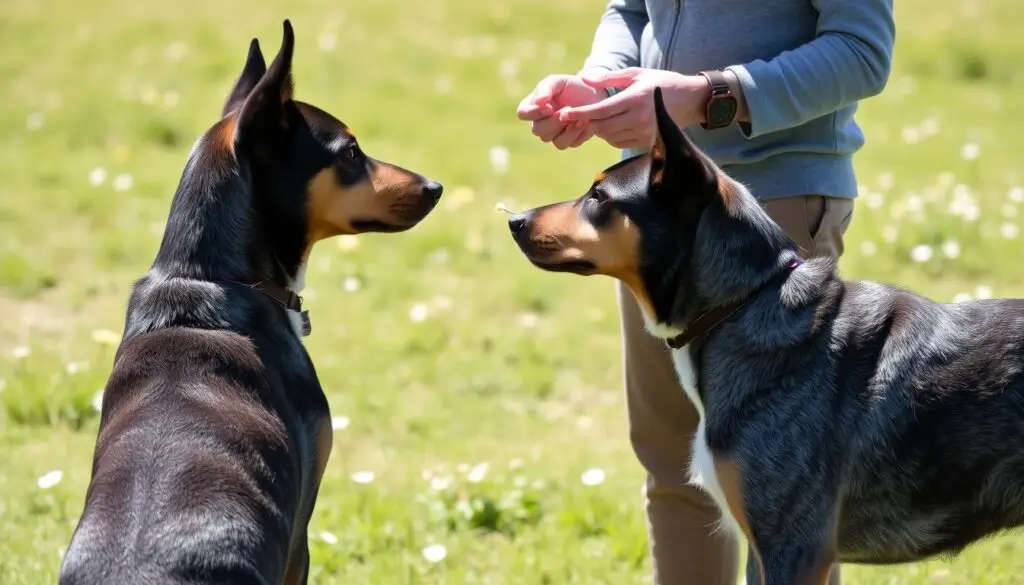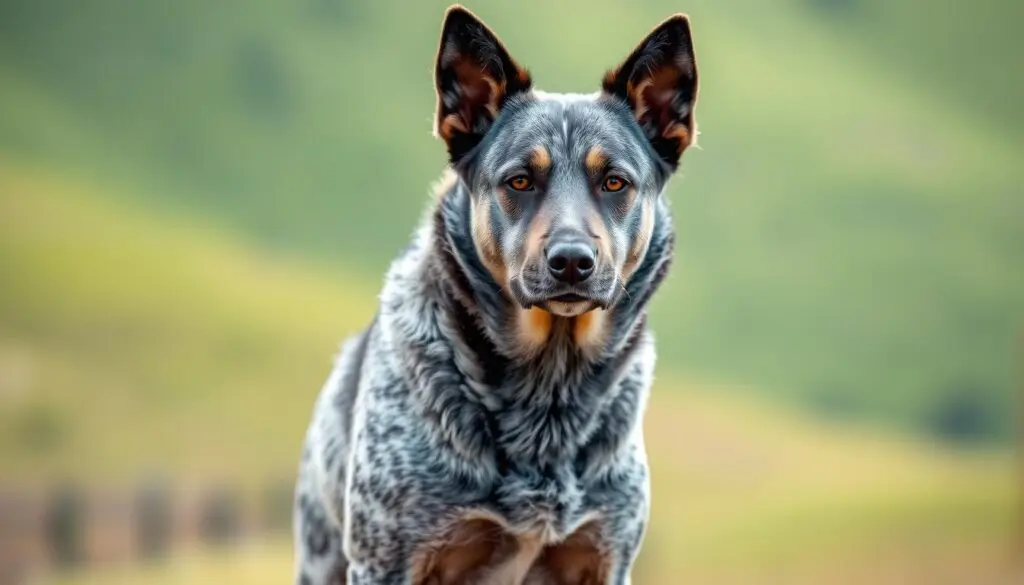Adopting A Blue Heeler: What You Need To Know
Thinking about getting a blue heeler, also known as an Australian Cattle Dog? They are smart and need lots of attention and exercise. Their high energy and love to please make them great companions. But, can you give them the care they need to stay happy and healthy?
Table of Contents
Key Takeaways
- Blue heelers are intelligent working dogs that require regular exercise and mental stimulation.
- They have high energy levels and need more than just a quick daily walk.
- Early training and socialization are crucial, especially for puppies.
- Blue heelers are generally protective of their homes and have a strong desire to please their owners.
- Their grooming routine is considered low-maintenance compared to other breeds.
- Adoption fees for blue heelers typically range from $200 to $500.
Understanding the Blue Heeler Breed
Thinking about getting a Blue Heeler? It’s key to know they’re loyal companions and full of energy. Hailing from Australia, they’re smart and love to work. These dogs are medium-sized, with a thick coat, and are known for their loyalty and smarts.
They watch over their family and home well, making them great guard dogs. Let’s dive into what makes them special:
Origin and History
The American Kennel Club (AKC) welcomed Blue Heelers in 1980. They’re high-energy dogs that need to stay mentally active. Mixed with dingo and other breeds, they were bred to herd cattle in Australia.
Physical Characteristics
Blue Heelers are 18-20 inches tall and weigh 40-50 pounds. Females are a bit smaller. Their short, double coat is easy to care for, coming in blue or red merle.
Temperament and Personality
Blue Heelers are smart and quick to learn. But, they need early socialization to control their herding drive. They excel in dog sports like agility and flyball, perfect for active owners.
Is a Blue Heeler the Right Dog for You?
The Blue Heeler is a great choice for active families with lots of space. They need lots of exercise and mental play. If you live in a small apartment, a Blue Heeler might not be the best fit.
But, if you have a big yard or love being outdoors, a Blue Heeler could be perfect for you.
Before getting a Blue Heeler, think about your lifestyle. They need about 1-2 hours of exercise daily to stay happy. They also need to meet new people often to avoid being shy.
Here are some important things to consider:
- Medium-sized dog with a weight range of 15-22 kg
- Approximately 43-51 cm tall at the shoulder
- Requires regular exercise and mental stimulation
- Needs regular socialization to prevent shyness or aggression
A Blue Heeler can be a great pet for the right person. They are smart, agile, and loyal. They do best in homes where they get lots of exercise and attention. Think about your lifestyle and what a Blue Heeler needs before deciding if they’re right for you.
Living Requirements for Your Blue Heeler
As an energetic breed and herding dog, your Blue Heeler needs the right living space. It’s important to think about the space, exercise, and climate. These factors will keep your dog happy and healthy.
Blue Heelers need lots of room to run and play. A yard or large outdoor area is a must. They also need at least 30 minutes of exercise each day. This may include walks, runs, or playtime in the yard.
They are also sensitive to extreme weather. So, it’s key to provide shade and shelter from the elements.
Some key considerations for your Blue Heeler’s living arrangements include:
- Providing a minimum of 1 hour of exercise daily or every other day
- Creating a safe and comfortable outdoor space for your dog to play and relax
- Ensuring your dog has access to shade and shelter from extreme temperatures
By understanding and meeting these living requirements, you can make a great home for your Blue Heeler. This ensures they stay happy and healthy as a herding dog and energetic breed.
The Adoption Process
Adopting a Blue Heeler involves several steps. First, you’ll need to fill out an application. Then, you’ll have an interview and a home visit. This ensures the dog will fit well in your home.
Adoption fees for Blue Heelers vary from $200 to $500. These fees cover initial vet care, vaccinations, microchipping, and spaying or neutering.
Adopting a Blue Heeler can be a fulfilling experience. You can adopt from a breeder, rescue, or shelter. Rescue organizations often have puppies and adult dogs ready for adoption.
When adopting, consider a few things:
- Energy level: Blue Heelers need lots of exercise and mental play.
- Training: They require consistent training and socialization.
- Space: They need room to move and exercise.

Adopting a Blue Heeler gives a loving home to a dog in need. The adoption process may take time. But finding the right companion is worth it. Make sure you understand Blue Heeler needs for a smooth transition.
Essential Health Considerations
As a Blue Heeler owner, knowing about potential health issues is key. Blue Heelers are generally healthy, but they can face certain problems. Regular vet visits, a good diet, and exercise are vital to keep them healthy.
Blue Heelers might get hip dysplasia, deafness, or eye issues. Progressive retinal atrophy can cause blindness, and deafness is inherited with no cure. Hip dysplasia can cause pain and arthritis, but supplements or NSAIDs can help.
To keep your Blue Heeler healthy, stay on top of vaccinations and preventive care. Maintaining a balanced diet and engaging in regular exercise are equally essential. Knowing about these health concerns helps you protect your dog’s well-being.
Here are some important health factors to consider:
- Hip dysplasia: a hereditary condition that may cause arthritis and mobility challenges.
- Deafness: an inherited condition with no treatment or cure available
- Eye problems: including progressive retinal atrophy and other inherited conditions
- Regular veterinary check-ups: essential for monitoring your Blue Heeler’s health and detecting potential issues early
By focusing on your Blue Heeler’s health and taking steps to prevent or manage issues, you can ensure a long, happy life for them.
Training Your Blue Heeler
Starting to train your Blue Heeler is a big step. This breed needs patience, the right guidance, and consistency. Early socialization is key to avoid fear and ensure good behavior. Positive reinforcement works well, using treats and affection to motivate them.
By putting in the time and effort, you can build a strong bond. This makes your Blue Heeler a well-behaved and loyal friend.
Some important things to remember during training are:
- Setting clear boundaries and commands
- Keeping them active and mentally stimulated
- Using positive methods like clicker training or treats
- Being consistent and patient, as they can be stubborn
Blue heeler training sessions should be short, about 15-20 minutes. This keeps them interested and energetic. Following these tips and dedicating time to training will help your Blue Heeler become a well-behaved and loyal companion.

Nutrition and Dietary Needs
As a Blue Heeler owner, it’s key to give your dog a balanced diet. Choose high-quality dog food that fits their needs. Make sure to feed them on a schedule to avoid overeating. Blue Heelers can easily get too fat, so watch their food closely.
A diet full of Omega-3 fatty acids helps their joints and reduces swelling. This is great for dogs with hip problems. Foods with lots of antioxidants, like Vitamin E and beta-carotene, are good for their eyes. Blue Heelers need about 38% protein in their food, especially if it’s dry.
- Feed a high-quality dog food that meets their nutritional needs
- Establish a feeding schedule to prevent overeating
- Monitor their food intake to prevent obesity
- Consider a diet rich in Omega-3 fatty acids for joint health
- Choose foods high in antioxidants for eye health
By giving your Blue Heeler a good diet, you can keep them healthy. Regular vet visits are also important. They help check your dog’s weight and adjust their diet if needed.
Grooming and Maintenance
As a Blue Heeler owner, you’ll want to establish a regular grooming routine. This keeps your dog clean, healthy, and looking their best. Their short, dense coat needs regular brushing to stay healthy and shiny.
Brush your Blue Heeler at least once a week. During spring and fall, brush them 2-3 times a week. This helps manage their shedding.
Trimming your Blue Heeler’s nails is also important. Do this every 3-4 weeks, based on their activity level. Weekly ear checks are crucial to watch for redness, irritation, or infection. Don’t forget to brush their teeth several times a week. A diet rich in omega-3 and omega-6 fatty acids will also help their coat shine.
Here are some key blue heeler grooming tips to keep in mind:
- Brush your Blue Heeler at least once a week, increasing to 2-3 times a week during shedding seasons
- Trim nails every 3-4 weeks, depending on activity level
- Check ears weekly for cleanliness and potential infections
- Brush teeth several times a week for optimal dental health
Regular grooming and maintenance prevent health issues. It keeps your Blue Heeler looking and feeling their best. By following these tips and establishing a regular routine, you’ll be a responsible and caring owner.
Conclusion: Embracing Life with Your Blue Heeler
Starting your journey with a blue heeler is exciting. They bring endless energy, loyalty, and smarts. With the right care and training, they’ll be a loving companion for years.
Blue heelers need lots of exercise and mental games to be happy. Activities like walks, jogs, and puzzle toys keep them busy. Positive training helps them grow and strengthens your bond.
Life with a blue heeler has its ups and downs. But with the right approach, you can have a great relationship. Enjoy their quirks, celebrate their wins, and make lasting memories together.

